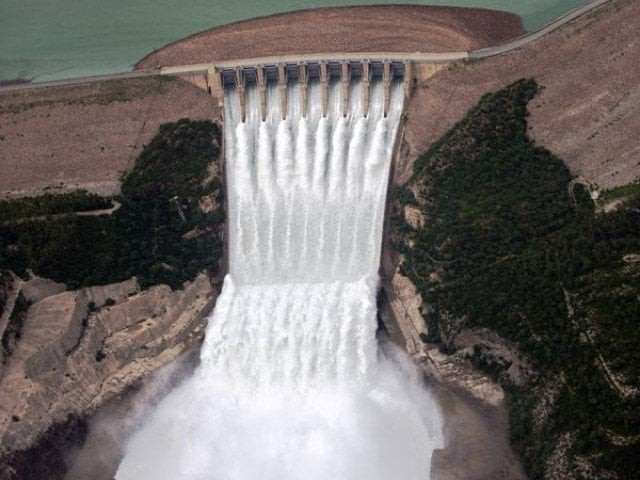Tarbela 141.31 feet higher than dead level
Indus River in ‘medium flood’ at Guddu

The water level in Indus River at Tarbela Dam was 1,539.31 feet, which was 141.31 feet higher than its dead level of 1,398 feet, the Indus River System Authority (Irsa) said on Saturday.
According to Irsa's data, the water inflow in the dam was recorded at 163,500 cusecs and outflow 114,9000 cusecs.
The water level in Jhelum River at Mangla Dam was 1,161.30 feet, which was 111.30 feet higher than its dead level of 1,050 feet.
The inflow and outflow of water there was recorded as 42,200 cusecs and 10,000 cusecs respectively.
The release of water at Kalabagh, Taunsa and Sukkur was recorded as 113,900, 242,100 and 316,300 cusecs, respectively. From Kabul River, 43,300 cusecs of water were released at Nowshera and a similar amount was released from Chenab River at Marala.
Separately, the Federal Flood Commission (FFC) has said that Indus River was flowing in ‘medium flood’ at Guddu (downstream Taunsa) and in ‘low flood’ at Sukkur.
According to the daily FFC report, all other main rivers of the Indus River System (Rivers Jhelum, Chenab, Ravi and Sutlej including Indus at Tarbela, Kalabagh, Chashma and Kotri) were flowing in normal flow conditions.
The combined live storage of the Tarbela, Mangla and Chashma is 7.726 million acre feet (MAF) (i.e. 57.39% of the total 13.461 MAF).
According to the Flood Forecasting Division (FFD), Lahore, a monsoon low had developed over Northwestern Bay of Bengal (India) and was likely to affect Sindh, Balochistan along with Dera Ghazi Khan Division in Punjab significantly from August 10 to 13. A westerly wave continues to prevail over Northeastern Afghanistan and adjoining areas with seasonal low lying over Northwestern Balochistan.
Mild moist currents both from Arabian Sea and Bay of Bengal are penetrating into the upper parts of the country up to 4,000 feet.
For the ensuing 24 hours, the FFD, Lahore has predicted scattered thunderstorms/rain of moderate intensity over the upper catchment of Indus River. Isolated to scattered thunderstorm/rain might also occur over Rawalpindi, Sargodha, Gujranwala, Lahore, DG Khan and Bahawalpur Divisions in Punjab, Sindh, Khyber-Pakhtunkhwa, Eastern Balochistan and the upper catchments of Jhelum, Chenab, Ravi and Sutlej rivers during the same period.
As per the FFD, Lahore’s "Weekly Significant Weather Outlook" for river catchments, scattered rainfall of moderate to heavy intensity with isolated very heavy falls was expected over upper catchments of all the major rivers. Widespread rainfall of heavy to very heavy intensity over Suleman Range (DG Khan and Rajanpur districts of Punjab as well as in Sindh and Balochistan was predicted from August 10 to 13.
Heavy rains might generate urban flooding in Rawalpindi/Islamabad, Gujranwala, Peshawar, Nowshera, Mardan, Faisalabad and Lahore Divisions during this period.
Flash flooding is expected in local nullahs of Islamabad, Rawalpindi, Shakargarh, Sialkot, Narowal, Abbottabad, Mansehra, Dir, Karak, Lakki Marwat, Bannu and Kashmir.
Heavy rains may develop urban flooding in Karachi, Thatta, Badin, Hyderabad, Dadu, Jamshoro, Sukkur, Larkana, Shaheed Benazirabad and Mirpurkhas from August 11 to 13.
Flash flooding might occur in Qilla Saifullah, Loralai, Barkhan, Kohlu, Mosa Khel, Sherani, Sibbi,Bolan, Kalat, Khuzdar, Lasbella, Awaran, Turbat, Panjgur, Pasni, Jiwani, Ormara, Gwadar and hill torrents of DG Khan during this period.
The catchment areas of Ravi, Jhelum and Chenab rivers might receive heavy downpour, causing water levels to rise significantly during the forecasted period.
All related organisations have been advised to remain vigilant, take timely actions on warnings issued by the bodies concerned to ensure safety of communities living in low-lying area, public and private property besides irrigation, drainage and flood protection infrastructure.





1735037907-0/Tribune-N-(2)1735037907-0-208x130.webp)













COMMENTS
Comments are moderated and generally will be posted if they are on-topic and not abusive.
For more information, please see our Comments FAQ